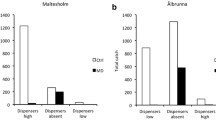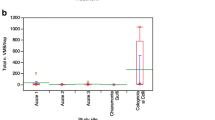Abstract
Mating disruption and mass trapping based on insect sex pheromones have been used to effectively control Grapholita molesta (Busck) (Lepidoptera: Tortricidae). However, due to the different disruption intensities of these two approaches, few reports have evaluated the differences in their ecological recovery in orchards. We investigated the dynamics of major Lepidopteran pests; infestation patterns of G. molesta in shoots and fruits; composition of the orchard insect community; and diversity, similarity, and stability indices, from 2015 to 2017, in peach orchards in northern China. Three orchards were considered, each subjected to either mating disruption, mass-trapping, or pesticides (control), from 2010 to 2013. Our results showed that moth pests and insect communities inhabiting these orchards responded differently to the two approaches. Mating disruption and mass trapping mainly affected the major and secondary non-target pests, respectively. Mating disruption had a greater effect on delaying the recovery of G. molesta than mass trapping. Mating disruption resulted in higher dominance index values and dominance concentration index values, and reduced the community stability while improving the community recovery. Mass trapping resulted in higher diversity index values, and the community exhibited contrasting effects. These results indicate that mating disruption may be more suitable than mass trapping for managing G. molesta in orchards.


Similar content being viewed by others
References
Andreev R, Olszak R, Kutinkova H (2006) Harmful and beneficial entomofauna in apple orchards grown under different management systems. IOBC/WPRS Bull 29:13–19
Belluco S, Losasso C, Maggioletti M, Alonzi CC, Paoletti MG, Ricci A (2013) Edible insects in a food safety nutritional perspective: a critical review. Compr Rev Food Sci F 12:296–313. https://doi.org/10.1111/1541-4337.12014
Bennett AB, Gratton C (2013) Floral diversity increases beneficial arthropod richness and decreases variability in arthropod community composition. Ecol Appl 23:86–95. https://doi.org/10.1890/11-2029.1
Brown MW (1993) Resilience of the natural arthropod community on apple to external disturbance. Ecol Entomol 18:169–183. https://doi.org/10.1111/j.1365-2311.1993.tb01087.x
Cardé RT, Minks AK (1995) Control of moth pests by mating disruption: successes and constraints. Annu Rev Entomol 40:559–585. https://doi.org/10.1146/annurev.ento.40.1.559
Chen SJ (2012) The cultivation status and development of peach industry in Shanxi province. Deciduous Fruits 44:24–26. https://doi.org/10.13855/j.cnki.lygs.2012.05.002
Chen YY (2017) Species and control of fruit borers in peach orchard of Yili prefecture. Jiangxi Agric 17:77. https://doi.org/10.19394/j.cnki.issn1674-4179.2017.17.066
Du J, Li GW, Xu XL, Wu JX (2015) Development and fecundity performance of oriental fruit moth (Lepidoptera: Tortricidae) reared on shoots and fruits of peach and pear in different seasons. Environ Entomol 44:15–22. https://doi.org/10.1093/ee/nvv124
El-Shafie HAF, Faleiro JR (2017) Semiochemicals and their potential use in pest management. In: Shields V (ed) Biological control of pest and vector insects. IntechOpen, London, pp 3–22
Fan RJ, Liu ZF, Lu JJ, Feng YT, Yu Q, Gao Y, Zhang RX (2013) Progress in the application of IPM to control the oriental fruit moth (Grapholita molesta) in China. Chinese J App Entomol 50:1509–1513. https://doi.org/10.7679/j.issn.2095-1353.2013.207
Gao BJ, Zhang ZZ, Li ZY (1992) Studies on the influence of the closed forest on the structure, diversity and stability of insect community. Acta Ecol Sin 12:1–7
Ge F (2008a) Principles and methods of insect ecology. Higher Education Press, Beijing
Ge F (2008b) Modern ecology. Science Press, Beijing
Hagley EAC, Monteith LG, Heme DHC, Trottier R (1977) Pest population buildup in apple orchards following omission of insecticide and acaricide sprays. P Entomol Soc Ont 108:7–11
Hao BF, Yu CL, Xu CX, He LM, Jiao R (2010) Study on species and occurrence regularity of fruit borers in peach orchard. J Hebei Agric Sci 14:72–73. https://doi.org/10.16318/j.cnki.hbnykx.2010.09.042
He YC, Yang J, Wang P (2018) Diversity and stability of terrestrial insect community in different wetlands in Yinchuan, Ningxia, Northwest China. Acta Entomol Sinica 61:439–452. https://doi.org/10.16380/j.kcxb.2018.12.009
Howell JF, Hutt RB, Hill WB (1978) Codling moth: mating behavior in the laboratory. Ann Entomol Soc Am 71:891–895. https://doi.org/10.1093/aesa/71.6.891
Hu ZL, Li HF (2010) A preliminary report on the occurrence regularity of oriental fruit moth in peach orchard. J Shanxi Agr Sci 38(46–47):54. https://doi.org/10.3969/j.issn.1002-2481.2010.06.15
Huang LP, Dong B, Yang P, Zhao WJ, Chen SJ (2014) Main local peach varieties in Shanxi province. China Fruit News 9:69–70
Il’ichev AL, Williams DG, Milner AD (2010) Mating disruption barriers in pome fruit for improved control of oriental fruit moth Grapholita molesta Busck (Lepidoptera: Tortricidae) in stone fruit under mating disruption. J Appl Entomol 128:126–132. https://doi.org/10.1111/j.1439-0418.2004.00822.x
Jiang XF, Luo LZ, Zhang L, Kang AG, Zhang YJ, Jiang YY (2009) Comparison of Jiaduo automatic pest forecast light trap and blacklight trap for monitoring trapping the meadow moth, Loxostege sticticalis. Plant Prot 35:109–113
Kishimoto H (2002) Species composition and seasonal occurrence of spider mites (Acari: Tetranychidae) and their predators in Japanese pear orchards with different agrochemical spraying programs. Appl Entomol and Zool 37:603–615. https://doi.org/10.1303/aez.2002.603
Kong WN, Hu RS, Zhao ZG, Li J, Zhang ZW, Li SC, Ma RY (2014a) Effects of trap height, location and spacing on pheromone-baited trap catch efficacy for oriental fruit moths in a peach orchard. Can Entomol 146:684–692. https://doi.org/10.4039/tce.2014.20
Kong WN, Li J, Fan RJ, Li SC, Ma RY (2014b) Sex-pheromone-mediated mating disruption technology for the oriental fruit moth, Grapholita molesta (Busck) (Lepidoptera: Tortricidae): overview prospects. Psyche. https://doi.org/10.1155/2014/253924
Kong WN, Wang Y, Guo YF, Niu GF, Chai XH, Ma RY (2018a) Optimum ratio and dose of different attractive sources to Grapholita molesta in the field. North Hortic 14:18–24. https://doi.org/10.11937/bfyy.20173631
Kong WN, Wang Y, Niu GF, Guo YF, Zhao F, Ma RY, Fan RJ (2018b) Screening and optimizing sex pheromone dispenser for Grapholita molesta. J Shanxi Agric Univ 38:8–12. https://doi.org/10.13842/j.cnki.issn1671-8151.200804003
Kong WN, Wang Y, Jia XT, Gao Y, Fan RJ, Li J, Ma RY (2019) Emergence and mating behavior of the oriental fruit moth Cydia molesta (Lepidoptera: Tortricidae) and its potential for reproduction. Ann Soc Entomol Fr 55:446–453. https://doi.org/10.1080/00379271.2019.1657361
Li J, Zhao LL, Li Y, Zhao ZG, Ma RY (2016) Inoculative releases of Trichogramma dendrolimi for suppressing the oriental fruit moth (Grapholita molesta) in peach orchard in China. Fruits 71:123–128. https://doi.org/10.1051/fruits/2015054
Ma KP (1994) Biodiversity measurement method I: a biodiversity measurement method. Chin Biodivers 2:162–168
Ma KP, Liu YM (1994) Biodiversity measurement method I: a biodiversity measurement method. Chin Biodivers 2:231–239
Pielou EC (1966) Species-diversity and pattern-diversity in the study of ecological succession. J Theor Biol 10:370–383. https://doi.org/10.1016/0022-5193(66)90133-0
Simon S, Defrance H, Sauphanor B (2007) Effect of codling moth management on orchard arthropods. Agr Ecosyst Environ 122:340–348. https://doi.org/10.1016/j.agee.2007.01.020
Simon S, Bouvier J, Debras J, Sauphanor B (2010) Biodiversity and pest management in orchard systems. A review. Agron Sustain Dev 30:139–152. https://doi.org/10.1007/978-94-007-0394-0_30
Snedecor GW, Cochran WG (1967) Statistical methods. Iowa State University Press, Iowa
Sonoda S, Izumi Y, Kohara Y, Koshiyama Y, Yoshida H (2011) Effects of pesticide practices on insect biodiversity in peach orchards. Appl Entomol Zool 46:335–342. https://doi.org/10.1007/s13355-011-0041-2
Sonoda S, Yamashita J, Koshiyama Y, Kohara Y, Enomoto T (2013) Short-term effects of mowing on insect communities in Japanese peach orchards. App Entomol Zool 48:65–72. https://doi.org/10.1007/s13355-012-0153-3
Stelinski LL, Miller JR, Ledebuhr R, Gut LJ (2006) Mechanized applicator for large-scale field deployment of paraffin-wax dispensers of pheromone for mating disruption in tree fruit. J Econ Entomol 99:1705–1710. https://doi.org/10.1093/jee/99.5.1705
Strickler K, Whalon M (1985) Microlepidoptera species composition in Michigan apple orchards. Environ Entomol 14:486–495. https://doi.org/10.1093/ee/14.4.486
Strickler K, Cushing N, Whalon M, Croft BA (1987) Mite (Acari) species composition in Michigan apple orchards. Environ Entomol 16:30–36. https://doi.org/10.1093/ee/16.1.30
Suckling DM (2000) Issues affecting the use of pheromones and other semiochemicals in orchards. Crop Prot 19:677–683. https://doi.org/10.1016/S0261-2194(00)00090-9
Sun Y, Li GW, Xu SC (2019) Progress in research on Grapholita funebrana. J Yanan Univ 38:92–96. https://doi.org/10.13876/j.cnki.ydnse.2019.02.092(102)
Szentkiralyi F, Kozar F (1991) How many species are there in apple insect communities?: testing the resource diversity and intermediate disturbance hypotheses. Ecol Entomol 16:491–503. https://doi.org/10.1111/j.1365-2311.1991.tb00241.x
Tian BL, Ma CS, Kong DC, Zhao CP, Wei GS (2012) The fruit moth population monitoring and control technique in different orchards. Acta Phytophy Sin 39:7–12. https://doi.org/10.13802/j.cnki.zwbhxb.2012.01.003
Wan NF, Gu XJ, Ji XY, Jiang JX, Wu JH, Li B (2014) Ecological engineering of ground cover vegetation enhances the diversity and stability of peach orchard canopy arthropod communities. Ecol Eng 70:175–182. https://doi.org/10.1016/j.ecoleng.2014.05.010
Wang QP (2017) Review of fruit production and marketing in Shanxi province in 2016 and analysis of the situation in 2017. China Fruit News 34:24–28
Witzgall P, Kirsch PA, Cork A (2010) Sex pheromones and their impact on pest management. J Chem Ecol 36:80–100. https://doi.org/10.1007/s10886-009-9737-y
Yang H, Zhang YJ, Chen J (2019) Survey of species and population dynamics of fruit borer in companion planting of apricot and plum. North Fruits 1:9–12. https://doi.org/10.16376/j.cnki.bfgs.2019.01.003
Yu DS, Yoo SH (2015) VBioindex: a visual tool to estimate biodiversity. Genom Inform 13:90–92. https://doi.org/10.5808/GI.2015.13.3.90
Zhang AS, Feng JG, Yu Y, Zhang SC, Li ZH (2003) The population dynamics and community structure of major pests and their natural enemies in peach orchards. Entomol J East China 12:65–71. https://doi.org/10.1005/1694-(2003)02-0065-07
Zhang LJ, Chen XD, Shuai S, Yang B, Qiu JW, Ma RY (2010) Experiment in application of sex pheromone to control of oriental fruit moth (Grapholita molesta) (Lepidoptera: Tortricidae). J Shanxi Agr Sci 38:97–100. https://doi.org/10.3969/j.issn.1002-2481.2010.07.27
Zhang ZW, Men LN, Peng YF, Li J, Deng A, Chen Y, Liu XQ, Ma RY (2017) Morphological differences of the reproductive system could be used to predict the optimum Grapholita molesta (Busck) control period. Sci Rep 7:8198. https://doi.org/10.1038/s41598-017-08549-y
Zhou LY, Ding SY, Lu XL, Liu YM (2020) Effects of anthropogenic disturbance on species diversity and niche of dominant group in pollinators community. Acta Ecol Sin 40:2111–2121. https://doi.org/10.5846/stxb201807021456
Acknowledgements
We would like to thank the undergraduate student assistants Wencui Liu, Jinghua Xie, Yujiao Dong, Ruixing Wang, Bo Liao, and Yi Li (Shanxi Agricultural University) for their help during experimentation. We are grateful to the Shanxi Key Research and Developmental Program (no. 201903D211001-1), the Shanxi Province Science Natural Science Foundation (no. 201701D121114), the Support and Training of the Shanxi Academy of Agricultural Science to the National Nature Science Foundation of China (no. YGJPY2005), and the Special Export Platform for Fruit Trading of the Shanxi Academy of Agricultural Science (no. YCX2018304), for their financial assistance.
Author information
Authors and Affiliations
Corresponding authors
Ethics declarations
Conflict of interest
The authors declare no competing interests.
Additional information
Publisher's Note
Springer Nature remains neutral with regard to jurisdictional claims in published maps and institutional affiliations.
Rights and permissions
About this article
Cite this article
Kong, W., Wang, Y., Guo, Y. et al. Effects of disruption of Grapholita molesta (Lepidoptera: Tortricidae) using sex pheromone on moth pests and insect communities in orchards. Appl Entomol Zool 55, 367–377 (2020). https://doi.org/10.1007/s13355-020-00691-w
Received:
Accepted:
Published:
Issue Date:
DOI: https://doi.org/10.1007/s13355-020-00691-w




